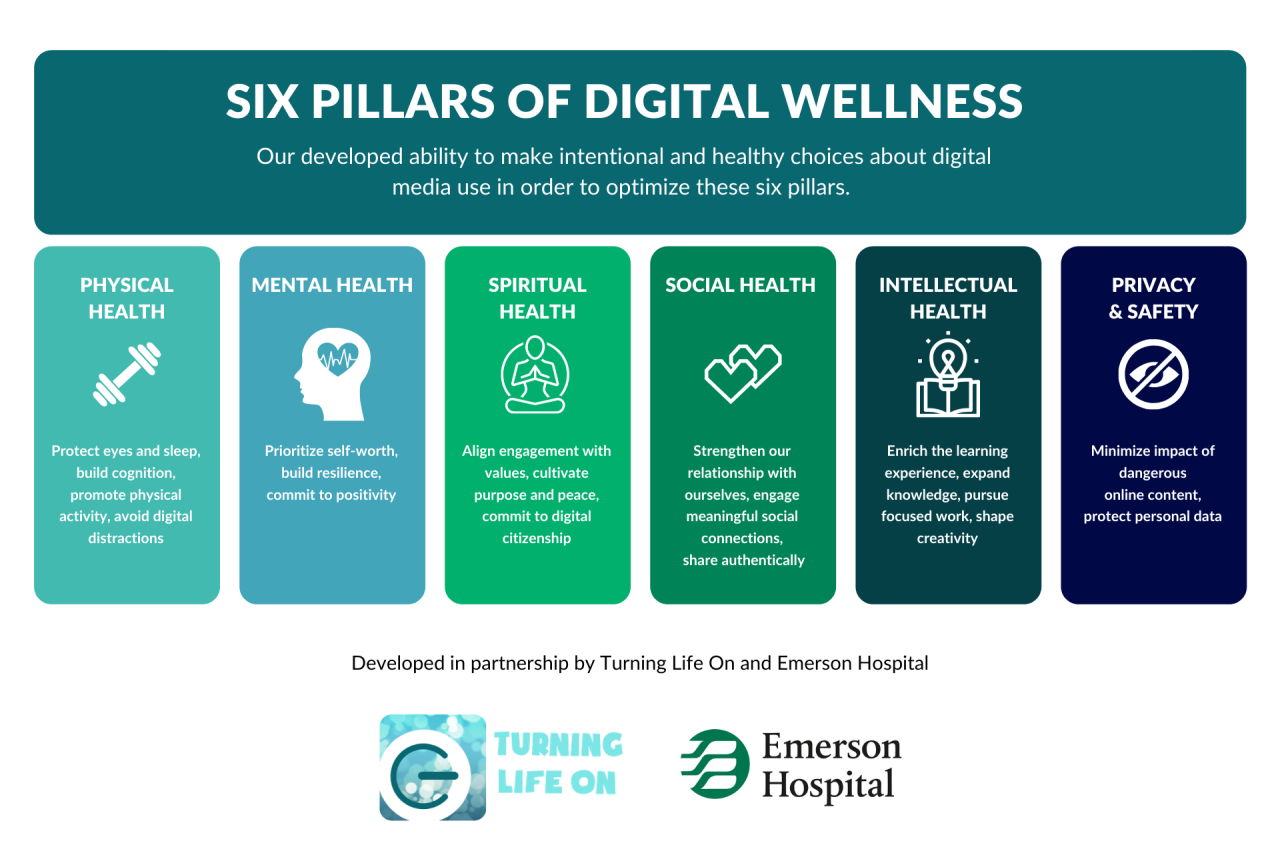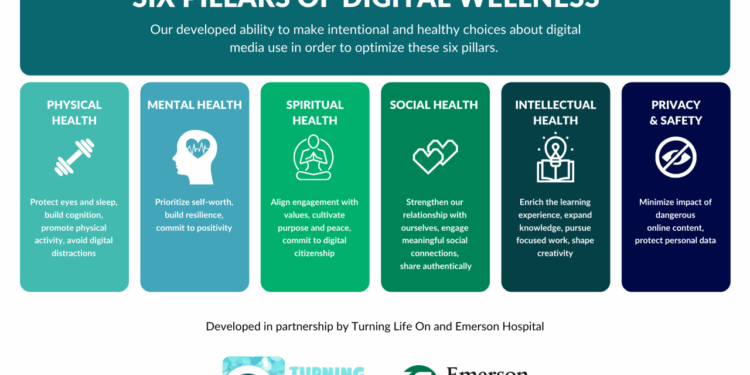Embark on a journey towards a healthier digital lifestyle with Digital Wellness Habits for a Healthier Digilife. This guide explores the importance of maintaining a balance in the digital world, offering insights on establishing healthy habits and mindful technology use.
Dive in to discover practical tips and strategies to enhance your overall well-being in the digital age.
Importance of Digital Wellness

Digital wellness refers to the conscious effort to maintain a healthy balance between the time spent using technology and other aspects of life. It involves adopting habits and practices that promote a positive relationship with digital devices and screens.
Impact of Digital Overload on Mental Health
Excessive screen time and constant connectivity can have detrimental effects on mental health. The constant barrage of notifications, emails, and social media updates can lead to feelings of anxiety, stress, and overwhelm. This digital overload can also disrupt sleep patterns, affect concentration, and contribute to feelings of isolation and loneliness.
Examples of How Digital Wellness Habits Can Improve Overall Well-being
- Setting boundaries: Establishing specific times to use devices and creating tech-free zones in your home can help reduce screen time and promote healthier habits.
- Practicing mindfulness: Taking breaks to engage in activities that do not involve screens, such as meditation, exercise, or spending time in nature, can help cultivate mindfulness and reduce stress.
- Managing notifications: Turning off non-essential notifications and setting boundaries around when and how often you check your devices can help create a more balanced and intentional relationship with technology.
- Prioritizing real-life connections: Making an effort to connect with friends and family in person or over the phone, rather than relying solely on digital communication, can strengthen relationships and promote overall well-being.
Establishing Healthy Digital Habits
In today's digital age, it's crucial to establish healthy habits when it comes to our technology use. By recognizing common unhealthy digital habits and implementing strategies to set boundaries with technology, we can create a healthier digital routine that promotes overall well-being.
Identifying Common Unhealthy Digital Habits
- Excessive screen time: Spending long hours on electronic devices can lead to eye strain, poor posture, and disrupted sleep patterns.
- Constant multitasking: Trying to juggle multiple tasks at once can decrease productivity and increase stress levels.
- Mindless scrolling: Endlessly scrolling through social media feeds can be addictive and detrimental to mental health.
- Ignoring real-life interactions: Prioritizing virtual connections over face-to-face relationships can lead to feelings of isolation and loneliness.
Strategies for Setting Boundaries with Technology
- Establish tech-free zones: Designate areas in your home, such as the dining room or bedroom, where electronic devices are not allowed.
- Set specific time limits: Use apps or built-in features to monitor and limit your screen time on different devices.
- Practice mindfulness: Be intentional about your technology use and take regular breaks to disconnect and recharge.
- Communicate boundaries: Clearly communicate your digital boundaries with friends, family, and colleagues to ensure they respect your limits.
Tips for Creating a Healthy Digital Routine
- Establish a morning routine: Start your day with activities that don't involve screens, such as meditation, exercise, or reading a book.
- Schedule screen-free time: Dedicate blocks of time throughout the day where you engage in offline activities, like going for a walk or cooking a meal.
- Create a bedtime routine: Power down devices at least an hour before bedtime to promote better sleep quality and relaxation.
- Practice digital detoxes: Take regular breaks from social media and technology to reset and refocus on your priorities.
Mindful Technology Use
Practicing mindfulness when using technology can bring numerous benefits to our overall well-being. By being present in the moment and fully aware of our actions, we can reduce stress, improve focus, and enhance our digital wellness.
Techniques to Practice Mindfulness
- Start your day with a digital detox: Begin your day without immediately reaching for your phone or computer. Take a few moments to breathe and set your intentions for the day.
- Practice mindful breathing: When using technology, take breaks to focus on your breathing. This can help calm your mind and reduce stress.
- Set boundaries: Establish limits on your screen time and create tech-free zones in your home to promote mindfulness and presence in the moment.
Enhancing Digital Wellness through Mindfulness
Mindfulness can help us become more intentional with our technology use, leading to healthier habits and a more balanced relationship with our devices.
By incorporating mindfulness into our daily interactions with technology, we can improve our mental clarity, reduce distractions, and cultivate a greater sense of well-being in our digital lives.
Balancing Screen Time
Balancing screen time is essential for both adults and children to maintain a healthy lifestyle in this digital age. Excessive screen time can have negative impacts on physical health, mental well-being, and relationships.
Importance of Balancing Screen Time
Excessive screen time can lead to an increased risk of obesity, poor sleep quality, eye strain, and a sedentary lifestyle. It can also affect cognitive function, emotional regulation, and social interactions. Finding a balance between screen time and offline activities is crucial for overall well-being.
Tips for Reducing Screen Time
- Set limits on screen time for yourself and your children, and stick to them consistently.
- Engage in offline activities such as exercise, hobbies, reading, or spending time outdoors.
- Create tech-free zones in your home, such as the dining table or bedroom, to promote face-to-face interactions.
- Use apps or tools that track your screen time and provide reminders to take breaks.
Strategies for Managing Screen Time Effectively
- Establish a daily routine that includes designated screen time for work, leisure, and social activities.
- Practice mindful technology use by being present and intentional with your screen time instead of mindlessly scrolling.
- Engage in regular digital detoxes by unplugging from screens for a set period of time, such as a weekend or vacation.
- Encourage open communication with family members about screen time habits and support each other in making healthy choices.
Digital Detox Practices
A digital detox involves taking a break from electronic devices like smartphones, computers, and tablets to reduce screen time and disconnect from the digital world. This practice allows individuals to reset, recharge, and focus on real-life interactions and activities.
Benefits of a Digital Detox
- Improved mental health: Reducing screen time can help alleviate stress, anxiety, and depression caused by constant digital stimulation.
- Enhanced productivity: Disconnecting from technology allows individuals to concentrate better, be more present, and accomplish tasks efficiently.
- Better sleep quality: Limiting exposure to screens before bedtime can lead to improved sleep patterns and overall well-being.
- Stronger relationships: Spending quality time with loved ones without distractions from devices can strengthen personal connections.
Planning a Successful Digital Detox
- Set clear goals: Determine why you want to detox and what you hope to achieve during this time away from screens.
- Inform others: Let friends, family, and colleagues know about your digital detox plan to manage expectations and reduce external pressure.
- Create a schedule: Decide on the duration of your detox, whether it's a day, weekend, or longer, and plan activities to fill your time.
- Find alternative activities: Identify hobbies, exercises, or social outings to replace screen time and keep yourself engaged.
Impact on Mental Health and Productivity
- Reduced stress: Disconnecting from digital devices can lower cortisol levels and promote relaxation, leading to decreased stress and improved mental well-being.
- Enhanced focus: By taking a break from constant notifications and distractions, individuals can concentrate better on tasks at hand and boost productivity.
- Increased creativity: Allowing the mind to rest from screens can inspire new ideas, creative thinking, and problem-solving skills.
- Emotional balance: Digital detox can help individuals reconnect with their emotions, thoughts, and surroundings, fostering a sense of balance and mindfulness.
Ending Remarks
In conclusion, embracing digital wellness habits is key to fostering a healthier relationship with technology and improving mental well-being. By implementing the tips and techniques discussed, you can create a more mindful and balanced approach to your digital life. Start your journey towards a healthier Digilife today.
Questions and Answers
What are some examples of digital wellness habits?
Digital wellness habits include setting boundaries with technology, practicing mindfulness when using devices, and balancing screen time with offline activities.
How can I reduce screen time effectively?
To reduce screen time, try setting specific limits on device usage, engaging in offline hobbies, and creating designated tech-free zones in your home.
What are the benefits of a digital detox?
A digital detox can help reduce stress, improve productivity, and enhance mental clarity by disconnecting from digital devices for a designated period.











